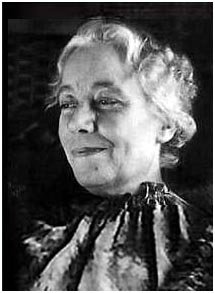Personality Course - Karen Horney
KAREN HORNEY

source
Karen Danielson was born near Hamburg, Germany, on September 15, 1885. She was the second child in an unhappy marriage of an often-absent Norwegian sea captain and his beautiful, higher-class wife. Danielson and her older brother Berndt were disciplined strictly by their tyrannical Lutheran father when he was home from long sea voyages. She retained a strongly independent character, regarded her father’s outspoken religious attitudes as hypocritical, and questioned the fundamentalist teachings of her church.
This was a time of social change in Germany, opening opportunities for women. Young Danielson entered the University of Freiburg in 1906, in a class of 58 women and 2,292 men. There she studied medicine, was popular, and married one frequent companion, Oskar Horney, in 1909. They moved to Berlin, where she continued her medical studies and he began a business career.
Karen Horney was a psychoanalytic patient of the Freudian analyst Karl Abraham. This was an avant-garde interest at that time. It was characteristic of her to explore new ideas, but she sought relief from personal problems as well: depression, fatigue, and dissatisfaction with her marriage. Her father died about this time, and she had ambivalent feelings toward him to sort out: anger because of the unhappiness of her parents’ marriage, but also more fondness for him than she admitted. The demands of combining a medical education with family life, without much encouragement from her husband, also required coping.
After receiving her psychiatric degree in 1915, she dared to lecture on the controversial Freudian theory and to defend it against critics. Her own challenges to the theory were still brewing.
Karen and Oskar Horney had three daughters. The couple had a troubled marriage and finally separated. Horney poured increasing energy into her career. She became one of the founding members of the Berlin Psychoanalytic Institute in 1920 and published several papers on male and female development, relationships, and marriage. Her 14 papers between 1922 and 1935 outlined a theory of female psychology that was clearly critical of Freud’s theory. Horney’s first suggestions were presented in a spirit of intellectual debate within classic Freudian theory, the sort of challenge that fosters the development of any science. The psychoanalytic community, however, dismissed her points and attacked her motivations. Freud is reported to have said of her, “She is able but malicious—mean” (Quinn, 1988, p. 237). He accused her of an inadequate analysis, saying that she did not accept her own penis envy (Symonds, 1991).
Given this hostile environment in Germany, it is no wonder that Horney accepted an invitation to become associate director of a new Institute for Psychoanalysis in Chicago, under Franz Alexander, in 1932. Then, in 1934 she moved to New York.
Ironically, the same sort of professional debates over theoretical orthodoxy that had impelled her to leave Germany divided the New York Psychoanalytic Institute, which in 1941 voted to remove her from her role as a teacher and clinical supervisor, demoting her to instructor.
Horney and her followers quickly formed a new organization, the Association for the Advancement of Psychoanalysis, and founded the American Journal of Psychoanalysis. The announcement of the new training institute contained a statement of commitment to nonauthoritarian teaching:
Students are acknowledged to be intelligent and responsible adults....It is the hope of the Institute that it will continue to avoid conceptual rigidities, and to respond to ideas, whatever the source, in a spirit of scientific and academic democracy. (cited in Quinn, 1988, p. 353)
It was not only the orthodox Freudians who were suspicious of her. The Federal Bureau of Investigation (FBI) kept a file on her because of her alleged communist sympathies, and she was for a while denied a passport. She was ultimately granted the passport, and in Japan she stayed at several Zen monasteries. In Zen Buddhism, Horney found support for the idea of a striving, healthy real self within the individual that Freudian theory did not offer. On December 4, 1952, within months of her return from Japan, she died of previously undiagnosed abdominal cancer.
As a person, Karen Horney seems to have had a capacity for enjoying life, despite the seriousness of her career and the disappointments of her marriage. She liked fine dining, concerts, and parties. She enjoyed relationships with men and had several affairs (Quinn, 1988). During Prohibition, she at least once spiked the punch by writ- ing her own prescription for “medicinal” alcohol (Quinn, 1988).
Horney challenged Freud’s claim that he had discovered universal developmental conflicts. Instead, she argued that personality and its development are influenced by culture and vary from one society to another. This energetic and nontraditional woman proposed new understandings of women, and of men, which today are more widely accepted than the classical Freudian theory she challenged. She is praised as an important role model for women and her writings had a major influence on feminist theory.
HORNEY’S THEORY
Interpersonal approaches in psychoanalysis have implications for major theoretical questions. Both Horney’s theory and relational approaches have inspired empirical research, not only within clinical settings but beyond, studying infants and children as well as adults. In addition to implications for adjustment and therapy, interpersonal approaches help us understand the variety of interpersonal styles that occur in everyday life.
Individual Differences
Individuals differ in the way they define themselves in relationships. Horney described a balance among three interpersonal orientations: moving toward, moving against, and moving away (from people). People have different idealized selves and use different ways of adjusting to anxiety.
Adaptation and Adjustment
Healthy interpersonal relationships are a key to adjustment, and they are based on acceptance of the true self instead of some defensive idealized self. Horney provides full descriptions of neurotic trends. Therapy focuses more on the present time and on interpersonal relationships than on the past and libidinal conflict (contrasting with Freud’s theory).
Cognitive Processes
Blind spots and other defense mechanisms limit insight, but courageous self-examination can lead to growth. Developmental and object relations theorists are studying specific cognitions, such as those related to emotion.
Culture
Culture is very important in shaping personality, especially through gender roles.
Biological Influences
Biology is far less important than orthodox psychoanalysis claims.
Development
Love and nurturance are key to a child’s development. In Horney’s theory, basic anxiety and hostility are the fundamental emotions of childhood. Without adequate parental love, the child develops unhealthy interpersonal modes and a defensive sense of self. Few major changes in personality occur after childhood (except through therapy).
IN-A-NUTSHELL
- Karen Horney revised psychoanalytic theory to emphasize interpersonal factors, and this theme has been expanded by later relational theorists.
- The child experiences basic anxiety as a result of parental rejection or neglect. This anxiety is accompanied by basic hostility, which cannot be expressed because of the child’s dependence on the parents.
- The child attempts to resolve the conflict by adopting one of three interpersonal orientations: moving toward people (the self-effacing solution), moving against them (the expansive solution), or moving away from them (the resignation solution).
- The healthy person can flexibly use all three orientations, but the neurotic person cannot.
- Horney described four basic strategies for resolving neurotic conflict: eclipsing the conflict, detachment, the idealized self, and externalization.
- The neurotic individual turns away from the real self, which has the potential for healthy growth, to an idealized self. The tyranny of the shoulds supports the idealized self.
- In addition, Horney described several secondary adjustment mechanisms: blind spots, compartmentalization, rationalization, excessive self-control, arbitrary rightness, elusiveness, and cynicism.
- Horney emphasized the cultural determinants of development. Parenting patterns vary from society to society; even the Oedipus complex is not a universal human experience in her theory.
- Horney discussed gender roles as developments shaped by particular cultures, which can change if cultures change.
- Horneyan therapy seeks to uncover unconscious conflicts originating in childhood but emphasizes their implications for present life.
- Relational theorists (a newer approach than Horney’s theory) also emphasize early parent-child relationships and their implications for a sense of self and for interpersonal relationships throughout life.
- Disturbances in object relationships contribute to many disorders, including narcissism, and to disturbed relationships in adulthood.
- In addition to contributors from psychoanalysis, developmental researchers investigating attachment have contributed to our understanding of object relations.
Reference - Theories of Personality - Understanding Persons, Susan Cloninger, The Sage Colleges, 6th edition




I've never heard of her before, but then history hides many great people
Very true. Thank you for stopping by. 😊
Wonderful, I'm so glad she found truth in Zen, the west is a dry place as far as spiritual philosophy is concerned so she did well to go to Japan.
I agree with you.
I had not heard of her that was such an interesting read and she achieved a lot and thanks for the info
I am tutoring a psychology class, that is why I share this info, I find it very interesting. I knew about her because of her feminist ideas 😉
And its good you are sharing this so more of us know about her and what she did